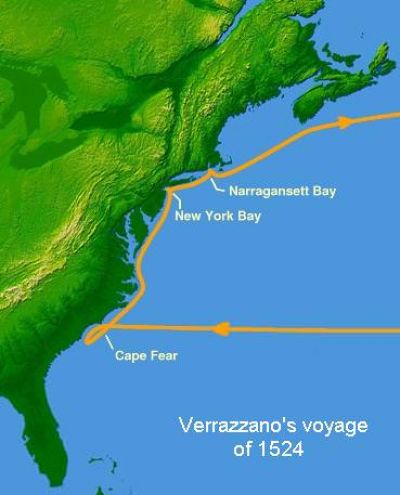Five hundred years ago, on April 17, Giovanni da Verrazzano and his crew were the first Europeans to sail into the estuary of what is now New York Harbor. Under Verrazzano’s command, they first landed at Cape Fear in North Carolina in March of 1524 and then traveled northeast along the coast of North America, leading into the New York Bay.
Sailing for King Francis I of France, it is noted that Verrazzano first served as a navigator in the French navy, moving to Dieppe, a seaport town on the northern coast of France, when he was in his late teens or early twenties.
Born in 1485 in Greve, Tuscany, the center of the Chianti wine region located about 15 miles south of Florence, Verrazzano was formally educated in the physical sciences of astronomy, cosmography, and geography. The Verrazzano estate, originally an Etruscan settlement, and vineyard in Greve had been under family rule since the seventh century. In 1819, with the passing of the last descendant, ownership of the property was transferred and went through several Florentine families until the late 1950s when it was acquired by the Cappellini family.
After the fall of the Roman Empire, merchants and governing officers in Italian city-states increased their focus on Asian trade. Beginning with the Crusades, starting in the late 11th century, to Marco Polo’s explorations during the late 13th century, the city-states and countries throughout Europe established and benefitted from trade with Asia. By the mid-1400s, journeys by land had become restrictive and dangerous, jeopardizing west-east trade, and causing Spain and Portugal to look at a sea passage. Portugal chose to establish a southern route, sailing along the coast of Africa. Spain chose to fund a sea voyage to the west. Encouraged by the expeditions of Colombo, Caboto and Vespucci, and with France also seeking to find passage to China by sailing west, Verrazzano was able to secure funding through French and Italian investors and planned the exploration at the request of King Francis I.
In late 1523, Verrazzano set sail from Dieppe with four ships, but shortly after departing, two ships were lost, and one was severely damaged during a storm. His ship, La Dauphine, landed on the Portuguese island of Madeira and began its journey west in mid-January 1524. In early March, the ship anchored near (what is now) Cape Fear, and on April 17 he entered what is now New York Harbor.
In his letter to King Francis I dated July 8, 1524, Verrazzano describes the events of his journey, the landscape and the people he encountered. In a translation of his letter about the harbor, he wrote: “After a hundred leagues we found a very agreeable place between two small but prominent hills; between them a very wide river, deep at its mouth, flow out into the sea; and with the help of the tide, which rises eight feet, any laden ship could have passed from the sea into the river estuary…Once we were anchored off the coast and well sheltered, we did not want to run any risks without knowing anything about the river mouth. So we took the small boat up this river to land which we found densely populated.”
The bridge that crosses New York Harbor, connecting Brooklyn to Staten Island has a history of controversy. First proposed in the late 1920s as the Liberty Bridge, it was devised to replace the defunct plans for a tunnel that would have connected the two boroughs of New York City. Over the years, numerous options were considered, and in 1959, construction of the suspension bridge began.
The naming of the bridge also caused much controversy. In 1954, John N. LaCorte, founder of the Italian Historical Society of America, prevailed in a successful campaign to acknowledge Verrazzano’s discovery of the harbor and, as plans for the construction of the bridge developed, he proposed naming the bridge for Verrazzano.
LaCorte gained additional recognition for Verrazzano from South Carolina, New Jersey, Maine, and Rhode Island, all states that Verrazzano had first landed near and explored the coastlines. LaCorte’s major obstacle was the director of New York’s public projects who refused to name the bridge after an Italian. But LaCorte persevered. Before construction, the bridge was named the Narrows Bridge. In 1960, Governor Nelson Rockefeller approved the renamed Verazzano-Narrows Bridge (with the incorrect spelling).
After President Kennedy’s death in 1963, talk surfaced of naming the bridge for him; but again, LaCorte continued with his mission of honoring Verrazzano and spoke with Robert Kennedy who assured him the name of the bridge would not change. Idlewild Airport in New York City would become John F. Kennedy International Airport.
In 2018, after a campaign to correct the spelling of the Verazzano-Narrows Bridge, it officially became the Verrazzano-Narrows Bridge.
The property in Greve, Castello di Verrazzano, is open to the public and throughout the year celebrates the life and history of Giovanni da Verrazzano.
https://www.lagazzettaitaliana.com/history-culture/10385-giovanni-da-verrazzano-and-the-naming-of-the-bridge#sigProIdecae6499b7




